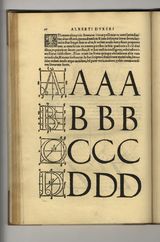Printing type: 1450 to 1830 (course in English) - James Mosley
 Some knowledge of printing type is essential in describing printed materials, and it can be of vital importance in assigning a reliable date and a place to documents in which these details are either absent or misleading. The object of this course is to trace the development of letterforms from the period of the invention of printing until its mechanization in the early 19th century.
Some knowledge of printing type is essential in describing printed materials, and it can be of vital importance in assigning a reliable date and a place to documents in which these details are either absent or misleading. The object of this course is to trace the development of letterforms from the period of the invention of printing until its mechanization in the early 19th century.
It will concentrate on the development of the design of printing types, and it will look at the relationship between letters used in other media (writing, sculpture and architecture), and explore the cultural, technical and economic factors that have had an influence on their development.
The course offers a broad historical overview under the following headings: gothic hands, gothic types, the revival of ‘antique’ capitals in Italy, the humanistic script and early roman and italic types, the ‘Aldine’ roman type in 16th-century France, the ‘Dutch taste’ (goût hollandois) in the 17th century, the ‘chancery cursive’ hand (cancellaresca corsiva) and the calligraphic revolution of the later 16th to 18th centuries, new types of the 18th century in France, Britain and Italy, and the commercial types of the first decades of the 19th century.
There will also be sessions in which original artefacts and documents will be examined. The collections of the City Library, Lyon, and the Museum of Printing provide original documents for study.
The course includes a session on the traditional process of making types with a punch, matrix and mould, with a demonstration of casting type by hand. Nelly Gable, punch-cutter at the Imprimerie Nationale wll give this demonstration.
Course in English with the possibility of discussion in both English and French.
James Mosley is a professor in the Department of Typography & Graphic communication at the University of Reading (UK). He was was for many years librarian of the St Bride Library in London. As a student he worked at the Water Lane Press in Cambridge, the bibliographical workshop of Philip Gaskell, and he had brief practical experience at a typefoundry in London. He has written and lectured extensively on the history of European and English typography. He curated the exhibition Le romain du roi: la typographie au service de l’État at the Musée de l’Imprimerie in 2002 and contributed to its catalogue. He added an introduction and notes to the facsimile edition of Fournier le jeune, Manuel typographique (1764) and of its English translation by Harry Carter that was published in 1995. His study of the revival of the sans-serif letter, The Nymph and the Grot (1999) was published to accompany an exhibition at the Soane Museum, London. His personal blog, with the title ‘Typefoundry: documents for the history of type and letterforms’ (http://typefoundry.blogspot.co.uk/) comprises a series of essays on these topics.